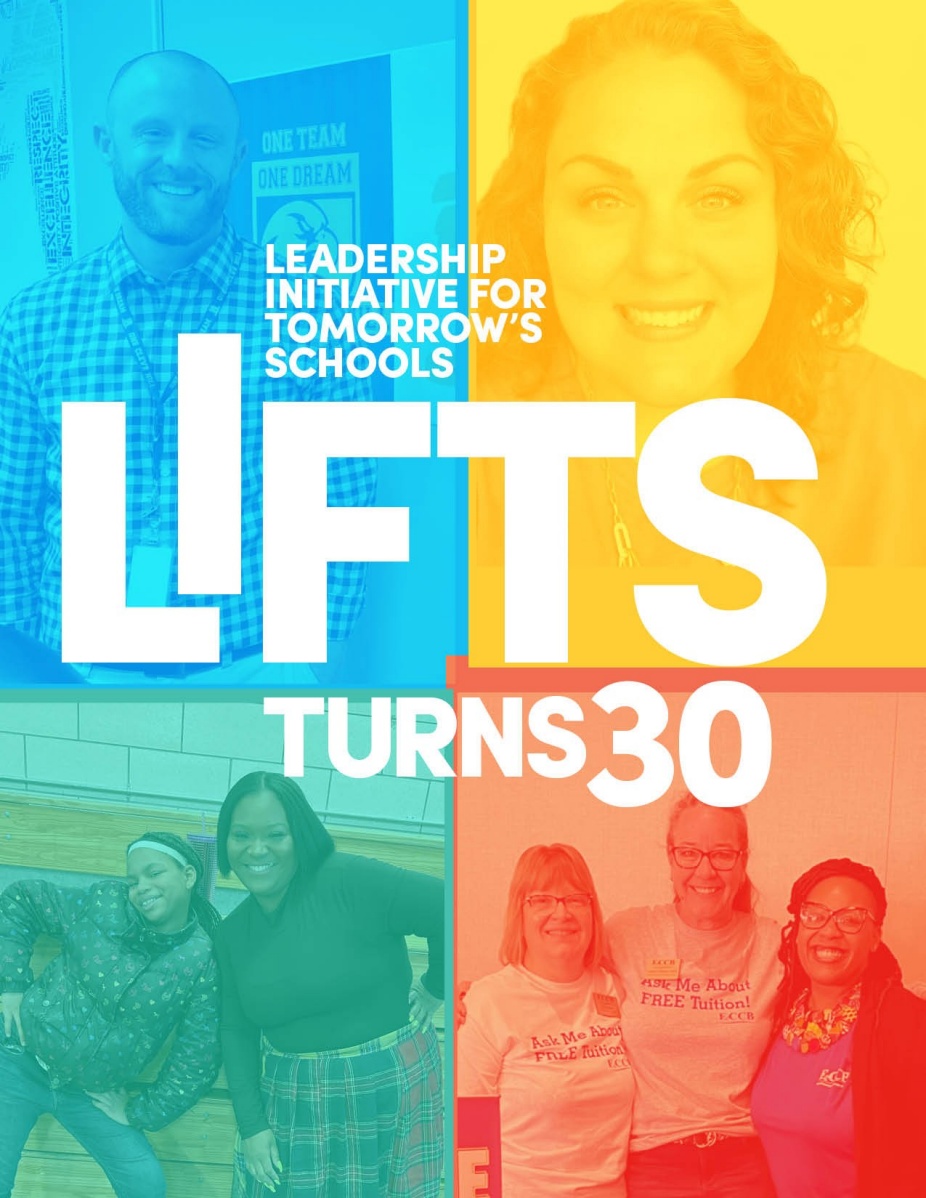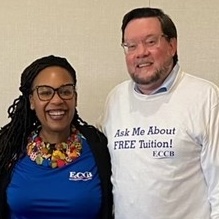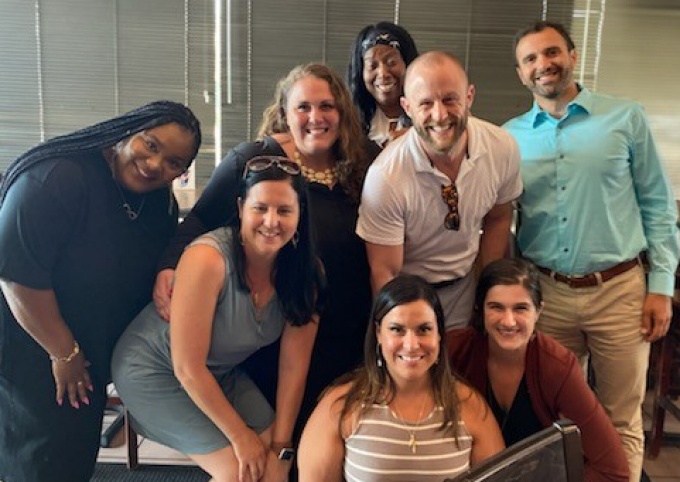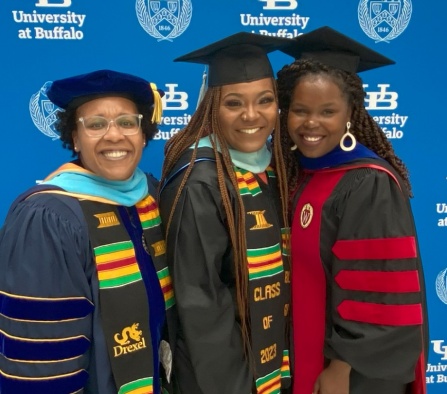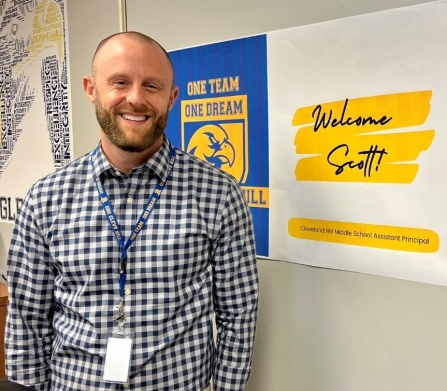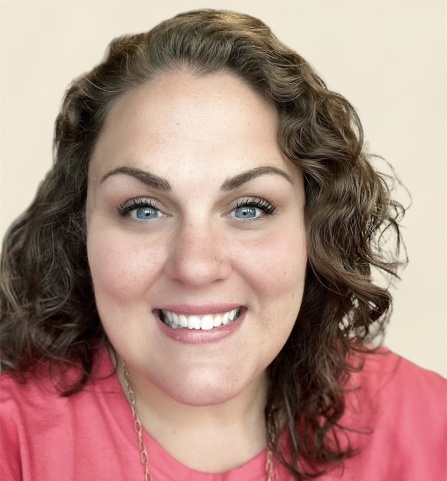LIFTS turns 30:
Celebrating the past, present and future of GSE’s innovative school leadership programming
BY DANIELLE LEGARE
In the early 1990s, UB Distinguished Professor Stephen L. Jacobson knew there was a leadership problem in Western New York’s K–12 schools. Local school districts could easily hire administrators, like principals and superintendents. But it was difficult to identify and retain true school leaders, qualified for and capable of tackling current and future issues in the field of education.
As a professor of educational leadership and policy and a former special education teacher, Jacobson had witnessed this problem himself. He had also heard about these challenges from his colleagues in Buffalo area school districts. And he realized that rethinking GSE’s administration certification program could be part of the solution.
After countless conversations and extensive research, Jacobson came up with an answer to the issue—and 30 years ago, GSE’s Leadership Initiative for Tomorrow’s Schools (LIFTS) administration certification program was born.
This story is a celebration of the 30th anniversary of GSE’s LIFTS program—an innovation in administration certification. The program has served as a model and problem-solver throughout New York State and the country. This spring, GSE’s community looks back and honors LIFTS’ rich history and robust future as it continues to build its legacy.
Soon after Jacobson was hired at GSE in 1986, local district leaders began to contact him to troubleshoot issues in their schools.
“They said to us, ‘Look, we’re having trouble finding people, and, if we’re having problems, I’m sure a lot of other districts are having those problems,’” Jacobson recalled. “So, we called a meeting, and it was a meeting of some of our faculty, particularly the junior people, some of the senior people, and four area superintendents—we had the superintendents of Buffalo, Williamsville, West Seneca, and Kenmore-Tonawanda [school districts]. And we began a conversation.”
Thomas L. Ramming, clinical associate professor emeritus of educational leadership and policy, remembers hearing about these conversations from Jacobson, who was his doctoral advisor at the time. As an educational administration EdD student, Ramming was intrigued—and, eventually, was asked to join those discussions.
“We listened to people in the field. We looked at the needs of our school districts. We wanted to meet the identified needs in the field versus maybe solely what folks in the ivory tower thought students needed to know to be successful,” said Ramming.
With every conversation, it became more apparent to Jacobson and Ramming that a novel approach was needed when preparing school administrators. “If you’re preparing people to do the job the way it’s being done today, you’re not giving them the skillset to be able to do the job that they’re actually going to come into four or five years in the future,” Jacobson said. “We began to think about: What are the primary skills that a person will have to have to be able to lead schools that we don’t even fully understand yet. We realized that the key things were good thinking and good interpersonal skills.”
“We wanted to meet the identified needs in the field versus maybe solely what folks in the ivory tower thought students needed to know to be successful.”
From Jacobson’s perspective, GSE’s existing program—with its focus on business, curriculum and instruction—was respectable. “But it was never pulled together,” he said. “It was as if we could teach you all of these isolated parts, and somehow, when you got out there, you’d figure out how it all fit.”
Jacobson began envisioning a cohesive and innovative program that engaged with area school districts for guidance. He saw its potential to attract outstanding program candidates, and imagined introducing these students to the field, equipping them with the skills needed to improve the lives of school-age children.
Invigorated by this vision, Jacobson embarked on a two-year planning process to build the new program.
First, the admission process needed to change. Rather than having faculty review submitted applications from prospective students, Jacobson decided the new program would make admission decisions based partly on receiving and reviewing district nominations.
“When you leave professors to pick, we select the attributes that are not necessarily going to work the best in the field. We’re going to select those people who have good grade point averages, and high GRE scores, and all of the things that ring all the right buzzers in the academy,” Jacobson explained. “But you can have people who are really bright but have no understanding of how to lead. So, we said, ‘If you know people—and you always do in a school district—who are outstanding and need to be tapped and encouraged to go forward, send them to us.’”
As the program developed, Jacobson determined that the internship was another area that needed improvement, and decided that a full-year, full-time professional experience was necessary. Rather than encourage internships within the districts where students were already employed, Jacobson saw the value in having students venture into other districts.
In the new program, students would work on more meaningful tasks and engage in real-world problem-solving. They would gain respect and confidence. And they would be paid—all while expanding their professional networks and experiences with the potential to inform the trajectory of their careers.
GSE’s former dean, Hugh Petrie, granted the LIFTS program a trial run for two years. He allowed it to run concurrently with the traditional program, and students could enroll in either the new or old program. While several students initially feared LIFTS’ unique approach to leadership preparation, that trepidation did not last long—especially among a specific population of students.
When the first cohort enrolled in 1992, LIFTS students looked different from those in UB’s traditional administration certification program. One noticeable shift: Unlike other school leadership programs, the first LIFTS cohort enrolled exclusively women.
“We realized the reason that women were taking the opportunity to do this is because they didn’t feel that going through the old program—ours or anyone else’s—was in any way advantageous. It was just leading into the old male-dominated line of succession into administration,” said Jacobson. “They felt they had less to lose. So, they said, ‘We will give it a try. If this means the district is already investing in us, maybe it increases our opportunity to actually get a position.’”
“Having attended LIFTS opened the door for my next step to administration and has provided me with a network of professionals ... who serve as a continuous support.”
Within just a few semesters, after noticing the advantages of the program’s full-time internship and supportive cohort model, all of UB’s administration certification students wanted to register for LIFTS.
GSE’s dean and faculty took note. Soon after, the traditional program was discontinued, and the new program continued to unfold with features that had not yet been offered in administration certification programming before.
The hallmarks of the new program, such as offering opportunities to intentionally build relationships and participate in valuable professional experiences, immediately proved beneficial. Students began the program entrenched in two full weeks of team building with their cohorts, intended to facilitate an understanding of the value and power of teamwork.
Laurie LiPuma, LIFTS ’13, chose to pursue the program because of the rigor of the curriculum and the in-person cohort model. Now the executive director of human resources for Erie 2-Chautauqua-Cattaraugus BOCES, LiPuma believes that the program taught her to become a reflective practitioner and profoundly impacted her career—partly due to the strength of her cohort and the greater LIFTS network.
“Having attended LIFTS opened the door for my next step to administration and has provided me with a network of professionals both from the cohort, and those we met during the program, who serve as a continuous support—even today,” she said.
“The model of working as a cohort and the experiences and exposure to expanding your network is crucial to your success as an administrator. Our best ideas are generated by working collaboratively with others. In addition, establishing a solid network allows you to work through the daily issues that surface when you can bounce things off of other professionals and not feel like you always have to create things from scratch,” LiPuma added.
Erika McDowell, clinical associate professor of educational leadership and policy, represented the LIFTS program at a recent recruitment event at Jackson State University. Also attending were Kelly Reed, human resources assistant, and Laurie LiPuma, executive director of human resources—both from Erie 2-Chautauqua-Cattaraugus BOCES.
Throughout the years, the LIFTS network grew. Students no longer connected just to their cohorts; they connected to alumni, who often sought ways to offer mentorship and remain involved with the program. For example, after graduating, LiPuma developed a sponsorship program at her workplace for future students considering LIFTS. To this day, up to two employees can enroll in the program every year to become future leaders at Erie 2 BOCES.
LIFTS students have also found ways to offer their support to faculty throughout the history of the program. Thomas Ramming still feels moved by the care he received from his students.
After a successful 34-year career in K-12 education, including 29 years in various leadership positions, and many years of serving as an adjunct instructor at GSE, Ramming was thrilled to secure a position as a clinical assistant instructor in the program in 2009. “It opened up, and I was lucky enough to get it. That was my dream job,” he said.
However, his early years as a faculty member were difficult. “I lost my wife when I was new to the program, and the students were really supportive,” he remembered. “They were good people.”
“One of the things I continue to appreciate is that graduates of the program will email me, text me and call me today for job advice, interview coaching and support,” Ramming added. “The fact that they’re still willing to reach out to me is something that I value.”
Early on, the LIFTS faculty understood that students needed to expand their networks beyond their peers and the faculty in their cohorts. They needed to connect with other professionals in the field to continue growing and thriving as future leaders. The LIFTS internship that Jacobson initially conceived allowed students to do just that.
“One of the things we heard very often was that our students were so much better prepared for day one on the job … They were getting paid, and people were expecting them to do the job well and were not very forgiving of first-year mistakes,” Jacobson said. “With the person who came through LIFTS, we didn’t see those kinds of first-year mistakes because they’d already spent the year doing that—and they had a network of people and mentors.”
David O’Rourke, LIFTS ’05, now the district superintendent and CEO of Erie 2-Chautauqua-Cattaraugus BOCES, was encouraged to pursue the program by his mentor. After enrolling, he quickly realized that the learning opportunities extended to him would significantly impact his life and career. O’Rourke cultivated strong relationships with his cohort, practitioners and GSE faculty. Through those connections and the curriculum, he observed a shift within himself: “It expanded my vision of leadership, and I began to see myself as a leader who could bring positive change to the organizations I served,” he said.
To this day, he still views the internship as a unique facet of the program—one that helped him achieve a career milestone. While completing his internship, O’Rourke was hired as director of instruction and technology in his first district leadership position.
With real-world internship experience came a real-world approach to assessment and feedback. Rather than assigning letter grades each semester, LIFTS faculty opted to draft written evaluations.
Jacobson implemented this grading policy to mirror the reality of the profession. He reasoned that students would never earn a letter grade at work, so they should not earn a grade in LIFTS courses. Instead, students received comprehensive analyses of their strengths and weaknesses, often leading to candid discussions about future growth and career plans.
Judging by the success of alumni who have gone on to thrive in leadership positions, Jacobson’s innovative method of creating student cohorts, professional experiences and valuable feedback has paid off.
As Jacobson initially predicted, today’s schools must navigate ever-changing needs and challenges.
Regardless of the size or location of the district, several schools face issues like addressing achievement gaps, striving to diversify staff and retaining teachers, among many others.
The program continues to evolve with the field.
Nathan J. Daun-Barnett, associate professor and chair of GSE’s Department of Educational Leadership and Policy, has observed these changes—especially the need for thoughtful, equity-focused leadership throughout Western New York.
“I think we’ve had to adapt to think about the changing context within which schools find themselves into thinking about some broader issues related to equity and social justice and inclusion, particularly in districts in areas where nobody’s raising them,” he said.
“We have a sense that equity, diversity and inclusion only matter in really diverse or segregated districts—like what we might experience in Buffalo—but it’s important for us to talk about equity issues when you’re out in Barker, Medina, Lackawanna or Lake Shore [districts],” Daun-Barnett continued. “These are issues that are affecting these communities that we do not talk about as much. And all educational leaders now have to think differently about those things in the wake of George Floyd and Tyre Nichols. We have had to adjust and adapt to think differently about how we prepare education leaders to view their role as leaders through an equity lens.”
GSE Dean and Professor Suzanne Rosenblith believes that engaging with a curriculum that goes beyond management and transactional training is critical for those who strive to become school leaders focused on building and strengthening relationships and support within a school or district. “You’re a principal because you’re an instructional leader, and you also carry the mission and values of the school and the district,” she said. “You are the champion of the students. You are a champion of the teachers.”
“You are the champion of the students. You are a champion of the teachers.”
After guiding countless prospective LIFTS students through the application process, Ryan Taughrin, GSE assistant dean for enrollment management, shares a similar perspective. “There are folks who are always called to lead. They want to run into the fire. They see issues, challenges, problems and ways of doing things differently, and they see the window of opportunity to make impacts or make a change structurally,” he said.
“We need those folks to come into programs like LIFTS because they need the certification to do these jobs, and we need people in our communities and our school districts who understand that leading a building and leading a district is really leading people—leading other teachers. We need those folks to develop skills outside of their building with other folks who are on that journey in similar ways to make an impact or to make a change,” Taughrin added.
While the program continues to evolve, the focus on providing students with the best experiences and preparation for leadership remains the same. “This program is well recognized and stands out because it has always put student preparation first,” said Rosenblith. “It has put detail first. It exemplifies our mission because it embodies what we look for in student-centered programming and in creating quality over quantity.”
Today’s LIFTS students have expanded their networks and skills, and are empowered and committed to serving as advocates to create positive change in their districts.
Members of the 28th LIFTS cohort—lovingly referred to as “The Great 28” by the cohort’s members.
Candace Dowdell describes herself as a teacher, basketball coach and advocate. She is also a member of the 28th LIFTS cohort—lovingly referred to as “The Great 28” by the cohort’s members.
Erika McDowell, clinical associate professor of educational leadership and policy, Candace Dowdell, LIFTS student, and Gwendolyn Baxley, assistant professor of educational leadership and policy, celebrate together at GSE's 2023 Commencement Ceremony.
After becoming a teacher leader at Highgate Heights Elementary School in Buffalo, Dowdell became interested in school leadership. However, her path to applying to LIFTS was trying. As a first-generation college student, she was afraid to pursue another degree. “The fear of failing at going back to school was a voice I had to silence,” she said.
Dowdell, now an instructional coach at PS #92 Build Community School, was admitted to the program in 2021. Upon feeling the support of her cohort—who is “like a family”—and interacting with the faculty, she knew ignoring the negative voices from within and pushing herself to enroll in the program was the right decision.
“I remember the first time I met Dr. Baxley! When I saw that she was a beautiful Black woman, I felt seen, heard and represented in the program,” Dowdell said of Gwendolyn Baxley, assistant professor of educational leadership and policy. “I’m sure my eyes lit up. Then, not to my surprise, Dr. Erika [McDowell], another gorgeous Black queen, came along and completely shifted our thinking and confidence as leaders to the next level.”
Through the connections she’s built, Dowdell is confident that she’s a stronger leader and advocate for change, and is prepared to implement the strategies she’s learned from the program in her career.
Scott Bielec’s journey into school leadership began during the COVID-19 pandemic. “I felt that students needed more help,” he said. “I also realized that I was more passionate about students 13 years into my career than I was when I first started.”
With his passion amplified, the former high school English teacher set his sights on the LIFTS program.
A member of the Great 28 cohort, Bielec admits that the program has been challenging—especially considering personal and professional responsibilities, including his new position as assistant principal at Cleveland Hill Middle School. “It has been hard work, but the people in my cohort have become some of my closest friends,” he said. “We help one another out.”
He also spoke highly of his professors, who have offered guidance with interviewing and finding leadership positions. “I have built great relationships with them, and I’ve found that they are there for me when I need them,” Bielec shared.
Looking ahead, he is eager to use the knowledge and skills developed in the program to continue growing in leadership positions. “In the end, I really just want to help students,” he said. “I hope that in leadership, I am better suited to help more kids in a more meaningful way.”
Erin Weir decided to pursue school leadership at the beginning of the COVID-19 pandemic, just after the birth of her first child. “Entering motherhood while experiencing the constraints as an educator helped me finally envision my ‘why,’” she said. “I wanted to become a change agent and advocate for not only my son but all children.”
She chose the LIFTS program because of its unique cohort model and the opportunity to build lasting connections and friendships with like-minded individuals. “Many online options are available for leadership coursework; however, I wanted to build lasting connections and friendships with those committed to impactful leadership,” said Weir.
She has done just that. She feels the program has given her a second family she looks forward to seeing every week in class. “I am grateful for the time we have spent diving deep, exploring not only who we are but the relevant topics that are pertinent to the areas of educational leadership in both a safe and brave space,” she said. “The dedicated professors in this program have brought the coursework to life.”
One of Weir’s most memorable moments in the program was spending her first semester participating in the summer “boot camp,” an intensive program that allows students to explore their core values and how those values drive leadership style. “It was the most introspective work I had ever done,” she said. “I am honored to have had the time to get to know my cohort, the professors, and most importantly, the time I took to get to know myself.”
After working as a speech-language pathologist in the Buffalo Public Schools for the past ten years, Weir recently accepted a position as the director of pupil personnel services in the Cheektowaga Central School District. She is thrilled to enter this leadership role with the lens of an empathetic communicator and therapist.
With Jacobson’s retirement in 2021 and Ramming’s in 2022, a new chapter of the program has begun.
Upon reflection, both faculty members fondly remember the program’s beginning and evolution and the achievements of their students.

Stephen L. Jacobson
“They’re my heroes, and the things that they’ve accomplished in their schools affect their teachers, which then affect their students,” said Jacobson. “It makes me feel like I have had some effect …That is what I am proudest of—the creation and the ongoing survival and development and growth of the LIFTS program.”
The retirements also offered a chance for a new wave of innovation.
As a trainer, educator, consultant and advocate, Erika McDowell was up for the challenge of serving as a faculty member in the program. McDowell, formerly the executive director of student support services in The School District of Philadelphia, joined GSE as a clinical associate professor of educational leadership and policy in the fall of 2022. She brought along her unique vision and philosophy to school leadership.
“I am a staunch equity practitioner. My goal is to give folks what they need to be successful,” she said. “I think every leader and every teacher comes to the work very differently, and it is my job to give you those skills and those tools that may be beneficial to you, and also give you that pedagogical and theoretical background to say, ‘OK, with these skills and who I am, how must I enact change in this district or in my environment so that all have a sense of love and belonging?’”
McDowell takes her role of supporting and guiding students seriously. Rather than waiting to discuss lofty ideas or problems of practice in class, McDowell’s students have her cellphone number, and she encourages them to use it when needing feedback or mentorship. Some students text to brainstorm rolling out a new policy or system at school. Others call to discuss elevating a concept from an assigned reading.
“I think, ‘How are the students? How are we supporting them?’ I think they are in a great place, but I want to continue that bubble of love, so they are getting what they need,” she said.
Her students feel that love. “There have been many transitions in our personal lives, as well as this program. I am so thankful that Dr. Erika joined the team,” said Candace Dowdell. “She is definitely a change leader and an advocate for her students!”
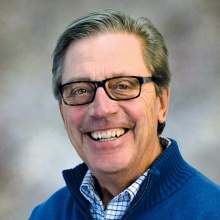
Thomas M. Ramming
Dowdell reports feeling assured that she chose the right university—largely because of McDowell’s arrival. “UB seems to be on an upward trajectory for change. I have observed the various efforts to magnify the voices of the BIPOC population. Representation matters, especially as a Black woman.”
While McDowell is excited and honored to support her students, she is also committed to taking a step back to assess both the field and the program. “We want to enhance the things that we are doing well, but we also sometimes need to course-correct based on shifts in time and shifts in what’s happening in our atmosphere,” she said. “I see the program ever-evolving, centering on our most beloved—the learners we are teaching. And we—the collective we, who is doing the work—must make sure our books and what we teach are reflective of the cultural and linguistic communities that we serve.”

Erika McDowell
After UB’s commencement ceremonies ended this spring, the LIFTS program kicked off another academic year and welcomed a new cohort.
At the same time, GSE faculty, staff and alumni have worked to put the finishing touches on a celebration taking place on July 13 in honor of the program’s 30th anniversary. “We have some good things in store. It is going to be a lovely large event,” said McDowell, who reports that she has been designated as the party’s emcee.
In addition to celebrating the program’s anniversary, the gathering will offer a space to commemorate Jacobson’s retirement after his 35-year career at UB—a celebration that was put on hold as a result of the pandemic.
Rosenblith looks forward to the festivities and the opportunity to honor the past, present and future of innovative school leadership programming at GSE.
“Hats off to Steve for what he did in creating this program and to all of the folks who carried it on throughout the years,” she said. “I’m also really looking forward to seeing where Erika and our other faculty take it. I think that they are going to build on it. Thirty years becomes a point to reflect and say, ‘We’ve done a good job, and now how can we make it even better and make sure that we’re still attending to its original purpose?’ I think that it is really in good hands, and I look forward to seeing what the next 30 years look like.”

